Battlefield Touring
It is surprisingly easy to tour the old battlefields of the Great War. A tour can be easily devised which takes you across (or under) the Channel, and down from Calais to Boulogne along the coast. There is plenty to see here, and also several great restaurants and hotels. The drive across country from Boulogne towards Armentières or Béthune is pretty pleasant in the summer, and you can then use either town, both well known to the Allied soldier of the time, as a base to tour the locations that the 38th (Welsh) Division, for example, held during the early months of the war.
The next step could be to follow the trail of the battalion south. The 38th (Welsh) Division was relieved from the Fromelles sector, infamous itself for the tragic Battle of Fromelles some weeks later, in June 1916 before making its epic march south to the Somme, and a few pleasant hour’s drive south will take you to the Department de la Somme.
Using Albert, a well known town to the Tommy, as a base, with its several hotels and restaurants, the entire area of the Somme battlefields of 1916 and 1918 is within easy reach and you can end your tour with a trip to Mametz Wood to admire David Peterson’s famous Red Dragon memorial, which overlooks the imposing mass of Mametz Wood.
This, of course, is just one example from many, but one which is close to my heart, and the reason why, in 2003, I dragged my family to France on our first tour of the battlefields and have been doing so ever since.
This page will hopefully be able to instil some confidence in a first time visitor to the Western Front, by showing how an amateur such as me has managed to make this once daunting trip!
The British and Commonwealth Armies fought in a massive area, coming down from Ypres in Belgium, to the River Marne, in France. This area encompassed cities and towns such as Ypres, Armentieres, Loos, Arras, Albert and Soissons, among others. Each area is worth visiting and offers a variety of places to stay, excellent Cafe’s, restaurant’s, museum’s, shopping and even theme parks.
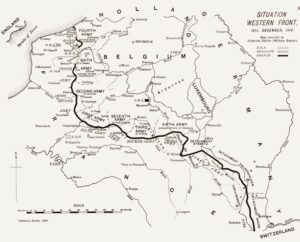
The above map shows the Western front in 1914. The Front was a continuous line of trenches spreading from the Belgian Coast in the North, to the Swiss border in the South. Millions of men were needed by both sides to maintain adequate defensive positions on the Western front.
There are several means of finding your way around the war cemeteries and memorials to the missing around the Western Front. One is the CWGC publication: ‘Michelin Road Atlas – Cemeteries and Memorials in Belgium and Northern France’ which is a handy glovebox sized atlas with cemeteries overlaid onto maps of France and Belgium, indexed in the back. The easiest way is to use a TomTom sat-nav and download the POIGRAVES file through the TomTom GO PC app. This is an excellent way to find your way around the cemeteries. The CWGC have also published an app for your mobile phone. Search in the app store for: ‘CWGC War Graves’.
The Ypres Salient (Ieper)
When we first started visiting Ieper, we used to stay at a small hotel called ‘The Shell Hole’, a unique Hotel, which was owned by John Woolsgrove, a former Paratrooper and his partner Christine, which also housed a Military Book and Medal Shop. These were some of the best trips we had, but when John retired, we began exploring other options, and have since stayed at almost every hotel in the city, as well as renting a house on our last trip.
This is the easiest, and most rewarding, trip to make as Ieper has something for everyone. Just book your Channel crossing, and then book somewhere to stay in Ieper. The crossing itself is interesting if you haven’t done it before. The tunnel is the quickest, while the ferry is the cheapest, if you can keep out of the duty free shop! The City of Ieper is an easy drive from Calais, with several possible routes to take, all of which have places of interest to visit along the way. The Ieper Tourist Office enables easy booking of somewhere to stay. We have never had a bad experience in Ypres, and have visited the city well over twenty times, and every hotel and restaurant we have stayed, and ate, in have been great.
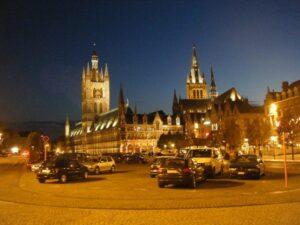
Our destination, Ypres. This is the centre of Ypres, and it’s magnificent Cloth Hall.
The Cloth Hall, which dominates the centre of the City, was totally destroyed during the Great War, due to Ypres being the centre of a Salient, jutting out into the German lines. This allowed the Germans to concentrate artillery fire onto Ypres from three sides. The Cloth Hall houses the ‘In Flanders Fields’ Museum and Tourist Centre, and is a recommended stop. The square itself is surrounded by Bars and Restaurants, all of which can be recommended for the quality of their food, and friendly service. Most of the inhabitants of Ypres seem to have a good grasp of the English language, making this a very nice place to stay with the family.
Ieper is central to many ideal places to visit. For those interested in the Great War, there are the nearby Museums of Hooge Crater and Hill 62. There is also an impressive display at nearby Zonnebeke, in the newly opened Streek Museum, which incorporated a reconstructed British Dugout, complete with displays and sounds, which can be walked through, while a short trip north will take you to the interesting Yser Tower and ‘Trenches of Death’ at Diksmuide. Below are a few photos of some of these places from our trips over the years.

The family, at the entrance to the German Cemetery, Langemarck
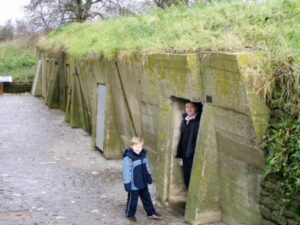
David and Myself by the preserved Essex Farm Dressing Station, where the Canadian Doctor, John McRae wrote his famous poem ‘In Flanders Fields’

Sophie and David with two of the Last Post Bugler’s, inside the Menin Gate.
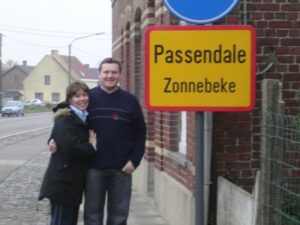
Annette and Myself, standing at the edge of the village of Passendale, the infamous objective of the murderous Battle of Passchendaele in the Autumn of 1917.
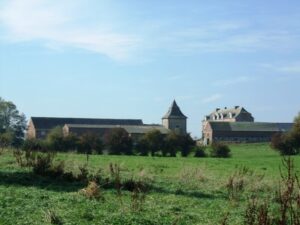
Ecuelin Chateau, where men of the 15th Welsh were billetted following the Armistice
To aid you in your trip to the Ypres battlefields, I can highly recommend Major and Mrs Holt’s Battlefield Guide to the Ypres Salient, which is packed full of information to help the visitor. The book shows several routes to Ypres from Calais, and also contains details of all of the actions fought in the area, as well as places to visit, and a very useful pull out guide map, which I use myself.
Flanders – The Neuve Chapelle and Loos Battlefields
Travel just a few miles south of Ieper along the line of the old Western front, and the route takes you past some infamous places: Messines Ridge, Ploegsteert Wood and Armentieres. Armentieres and Bethune are two delightful towns situated in this sector of the battlefield, which both offer a wide variety of places to stay and places to eat. We particularly like Bethune, as its square, centred around the Belfry, which was a well known landmark during the war, is surrounded by shops, cafes and restaurants.
Within easy travelling distance of either town are the battlefields of Aubers Ridge, Neuve-Chapelle, Fromelles and Loos, and the countryside seems to be littered with Commonwealth War Cemeteries, all of which are worth visiting.
Notably here is the latest Commonwealth War Graves Commission cemetery to have been built after the discovery of several large burial pits recently. Fromelles (Pheasant Wood) Cemetery contains around 250 graves of men who were originally buried in pits overlooked by the cemetery. Presently some 96 have been identified. Nearby is another site worth visiting, VC Corner Cemetery and the Fromelles Memorial Park pay tribute to the Australians who died during the ill fated diversionary assault on the Sugar Loaf salient.
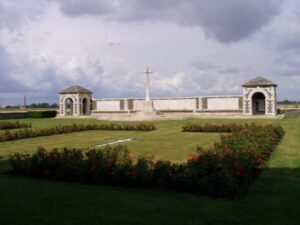
VC Corner Cemetery, Fromelles
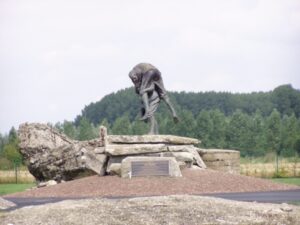
Fromelles Memorial Park
There are also several of the CWGC’s main war memorials in the area: near Neuve-Chapelle itself are the impressive Indian Memorial and the picturesque Le Touret Memorial and Military Cemetery, whilst at Loos is the solemn Loos Memorial, which encloses Dud Corner Cemetery, and offers views over most of the Loos battlefields.
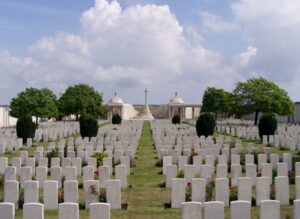
Loos Memorial and Dud Corner Cemetery
Nearby is the spectacular Vimy Ridge, which is surmounted by the impressive twin pylons of Canada’s Vimy Ridge Memorial, their national monument which commemorates the men who took part in the capture of this vital position who have no known grave. The memorial is located within a memorial park, which is a must to visit. If you are interested, you can also book a tour in the Grange Subway, one of the tunnels which runs below the park, and which was used during the capture of the position.
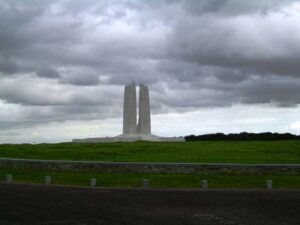
The Vimy Memorial
To aid you in your trip to the Flanders battlefields, I can highly recommend Major and Mrs Holt’s Battlefield Guide to The Western Front, North, which is packed full of information to help the visitor. The book shows several routes to the battlefield from Calais, and also contains details of all of the actions fought in the area, as well as places to visit, and also covers some of the Ypres battles.
Arras and the Somme Battlefields
Moving south once more, the first major city is Arras, again well known to the Tommy during the war (and also during WW2 when the Welsh Guards fought a famous action here). Arras itself is a great place to stay, and can be used as a base for touring the Arras Battlefield, and also the battlefields of Cambrai and the Hindenburg Line. It is also close enough to the Somme to be used as a base for touring there. Within the town are several CWGC cemeteries, including the impressive Arras Memorial, which encompasses the RAF Memorial and the Faubourg d’Amiens Cemetery. To find places to stay in the Somme and also to find out more about events and places to visit, please visit the Somme Tourism website.
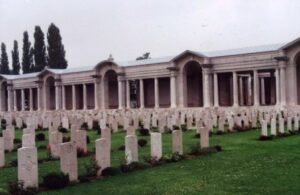
The Arras Memorial
On our first ever trip to the Somme, we stayed at Auchonvillers, with Avril Williams, in her fantastic B&B, which has an authentic First World War Advanced Dressing Station in the cellar, and have also rented Gites in Mailly Maillet, Longueval and Flers. Amiens or Péronne could also be used as a base to explore the Somme, and you could then visit the hotels and restaurants frequented by the officers and soldiers when they were off duty.
If visiting the Somme, it is essential to have a car and to be prepared to travel a few miles, as it can be used as a base for visiting the area from Vimy Ridge across to Cambrai, down to St. Quentin, Péronne, to Albert and Amiens. There is plenty to see, and we have only just scratched the surface in our visits.
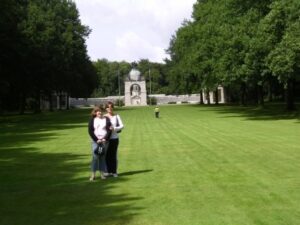
Sophie and Annette in the grounds of the South African Memorial at Delville Wood.
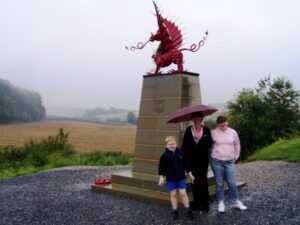
Annette and the children again, this time stood by the fantastic Memorial to the 38th Welsh Division at Mametz Wood. The memorial was made by St. Clears man, David Peterson, and stands at the point where the Welsh Division began their attack on the formidable German positions inside the Woods.
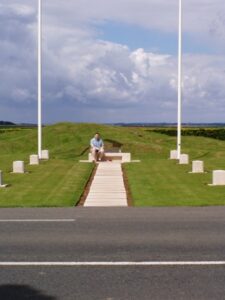
The site of the old windmill, at the North East edge of Pozières village.
The Windmill was a German strongpoint, that was one of the objectives for the First Australian Division’s attack on the village, of which my Great Grandfather David Thomas John took part. Thousands of Australian’s died in the struggle for Pozieres. Just take a look at the photograph below to get an idea of the destruction. The shell is bursting on the site of the windmill, where I am sat, and the village has been completely destroyed.
To aid you in your trip to the Flanders battlefields, I can highly recommend Major and Mrs Holt’s Battlefield Guide to the Somme, which is packed full of information to help the visitor. The book shows several routes to the battlefield from Calais, and also contains details of all of the actions fought in the area, as well as places to visit. The accompanying map has also proved to be of great use to me over several visits.
The Hindenburg Line Area
The Hindenburg Line battle area stretches from Arras southwards to Laffaux, near Soissons, on the Aisne. The Germans had constructed it in able to shrink the length of front which they had to hold, and created a heavily fortified system of trenches, laced with belts of barbed wire, and defended by scientifically calculated fields of fire, covered by countless machine-guns. The allies first saw the Hindenburg Line early in 1917, when the stretched German army retreated to its safety. Part of the Battle of Arras saw considerable fighting on the Hindenburg Line near Bullecourt. The northern sector was fought over in the winter of 1917, during the Battle of Cambrai, which saw the Allies breach the defences, but they were unable to consolidate their gains, and a swift counter-offensive drove them back.
The Germans launched Operation Michael from here on 21 March 1918, and it took a desperate defence to stem their attempt to cut off the BEF. Following the launching of the 100 days offensive (the Advance to Victory) on 8 August 1918, the Allies drove the Germans back towards the Hindenburg Line again, and the area saw heavy fighting during the defence, and subsequent breaking through, of the Hindenburg Line during September 1918.
There is much to see along this rarely visited part of the Western Front, with many traces of emplacements, bunkers and trench-lines to be found, as well as such notable landmarks as the Canal du Nord and the Riqueval Bridge. I have personally traced the progress of the 38th (Welsh) Division, and the 74th (Yeomanry) Division through and beyond this part of the battlefield, and have found it to be a most interesting and rewarding experience. It is easy to carry out a good deal of exploration of this area from a base in Albert, but I would also recommend Péronne as a lovely place to stay, with its picturesque location on the banks of the River Somme, and it’s fantastic museum, the Historial, which is located inside the ruins of an ancient chateau.
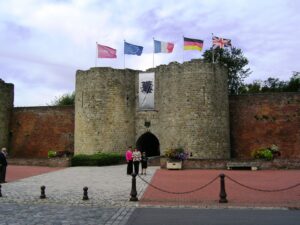
The Historial, at Péronne
For anyone visiting this area, I strongly recommend bringing a copy of the book Hindenburg Line, by Peter Oldham, which is part of the Battleground Europe series. The book covers the history and battles of each sector of the line, and contains many maps and pictures, even illustrating the whereabouts of surviving emplacements.
The Southern (Aisne) and French Sectors
I can’t profess to being an expert on these locations, but we have enjoyed two brilliant days out from our base at Longueval one summer. The first we combined with a trip to Disneyland Paris, which also took in the La Ferté-sous-Jouarre Memorial, which commemorates the missing of the retreat to the Marne in 1914. The second trip followed the line along the Chemin-de-Dames ridge, to follow William Fuller’s exploits while winning his Victoria Cross with the 2nd Welsh in 1914. We explored the beautiful towns of Soissons and Rheims, the famous centre of the Champagne industry, and visited notable 1914 battlefield sites, such as Chalons-sur-Marne, and Chivy-sur-Aisne. I think I would stay in Rheims when we next visit, as it’s a lovely town, and it would be great to enjoy some Champagne testing events.
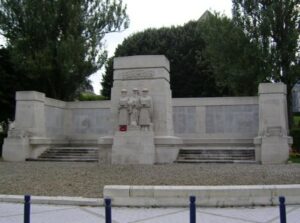
The Soissons Memorial
For anyone visiting this area, I’d recommend Major and Mrs. Holt’s Battlefield Guide to The Western Front, South, which covers the entire battlefield in great details, and also advises on routes from Calais and places to stay in the area.
Gallipoli
I haven’t been lucky enough, or had the time, to visit Gallipoli yet, but it is definitely on my bucket list, as my great grandfather fought there and several Laugharne men were killed on its desolate slopes. I have, however, studied in detail the possibility of going, using Major and Mrs. Holt’s Battlefield Guide to Gallipoli. The book, as with their others, contains a very useful battle map, and will certainly be one of the first items I pack when I do go.
D-Day and the Normandy Landings
Again, I have yet to visit Normandy, although I have visited WW2 sites further north along the Channel coast, but it is another place which is on my bucket list of places to visit. Again, Major and Mrs Holt have excelled, with their book The Definitive Battlefield Guide to the D-Day Normandy Landing Beaches, which includes a detailed battle map of the area.
Operation Market Garden
The famous film, A Bridge Too Far, chronicles one of the most famous episodes of the war, with General Bernard Montgomery’s plan to shorten the war by forcing the crossing of the River Rhine. Our local battalion, the 4th Battalion, Welch Regiment, took part in this offensive, as part of the 53rd (Welch) Division, and are forever remembered today by the townspeople of the town of s’Hertogenbosch, which they liberated in 1944. To follow the route, and the trials and tribulations of the paratroopers who were isolated at Arnhem, I recommend Major and Mrs Holt’s Battlefield Guide to Operation Market Garden, which again has a battle map.